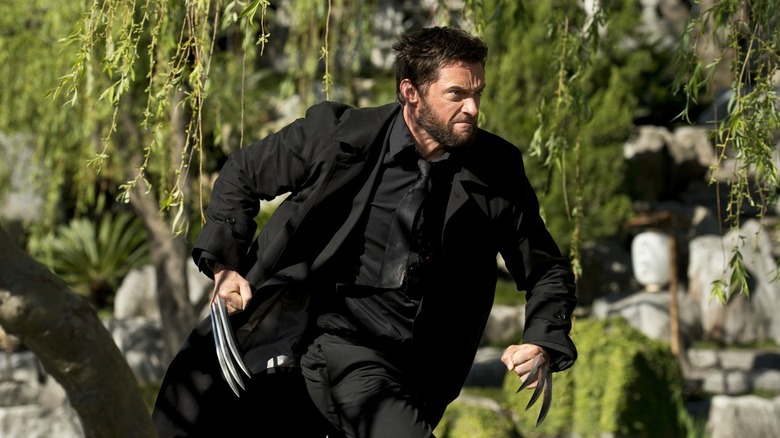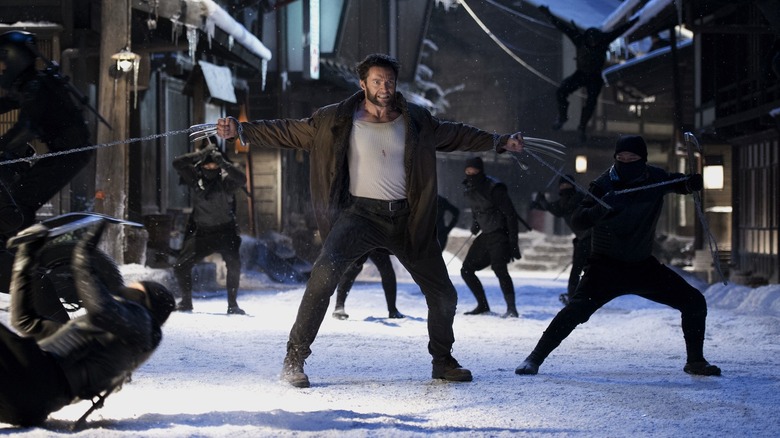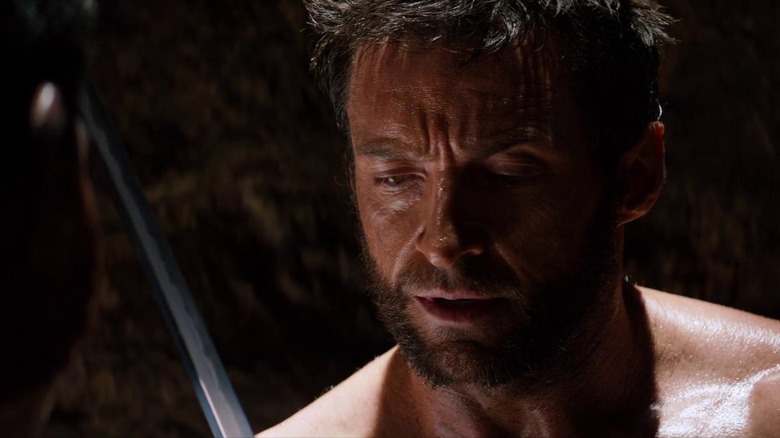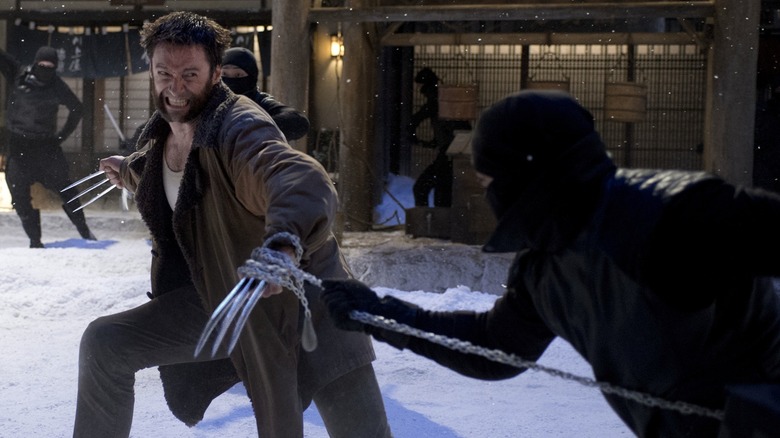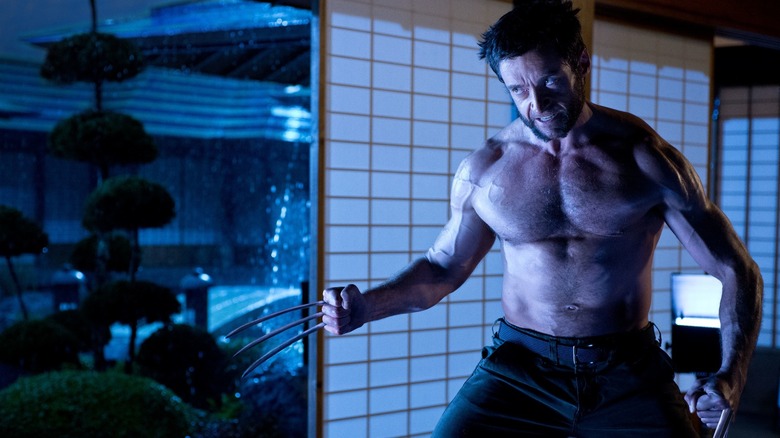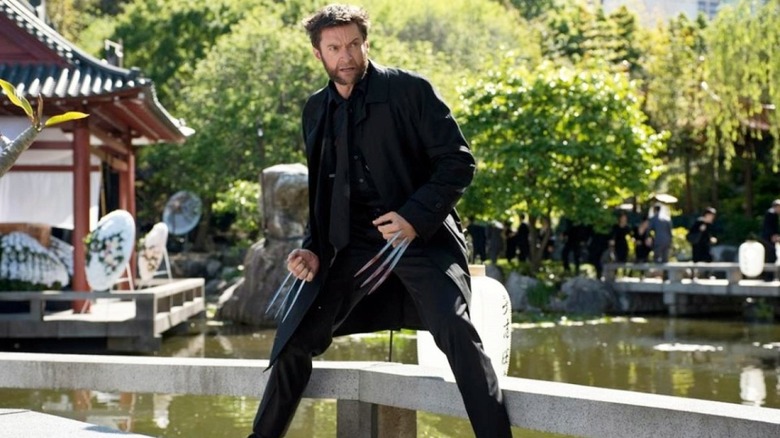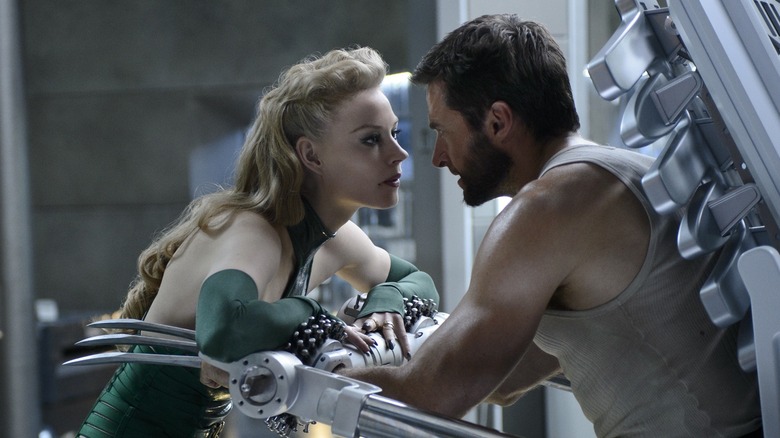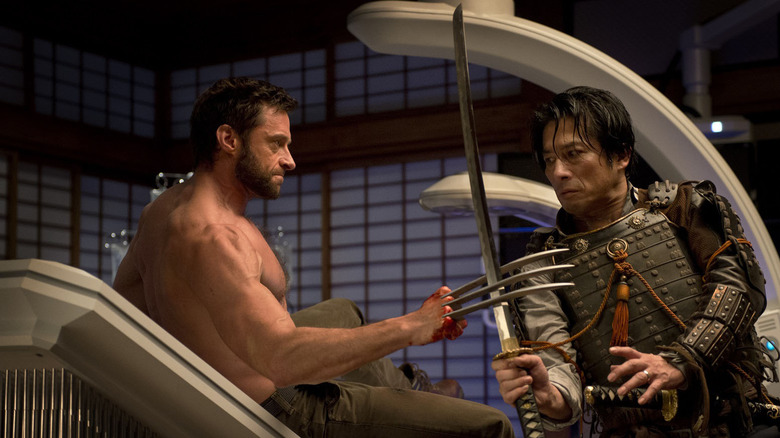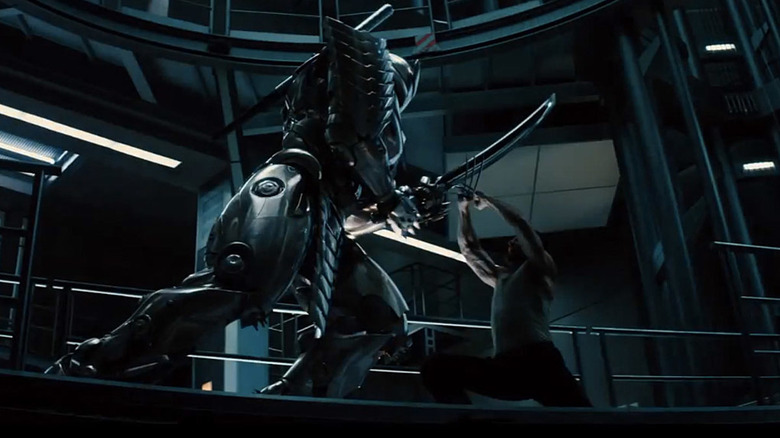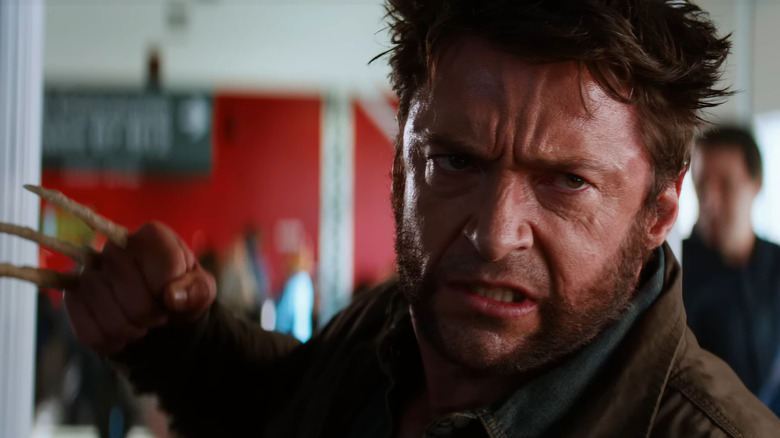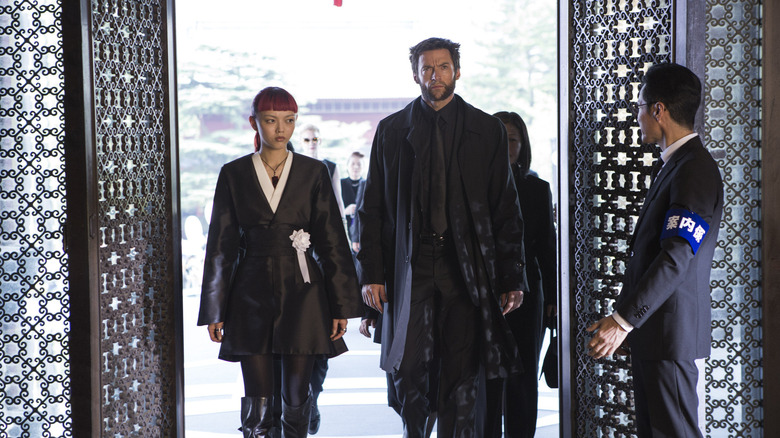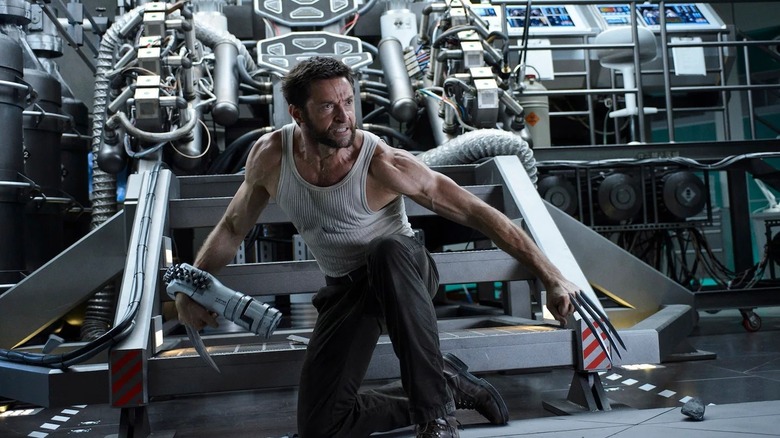The Untold Truth Of 2013's The Wolverine
Two of the solo "X-Men" movies starring Hugh Jackman's Wolverine never seem to die in terms of public recognition. 2009's "X-Men Origins: Wolverine" will always be remembered for its dire quality and some truly baffling decisions like its bizarre version of Deadpool. Conversely, 2017's "Logan" is constantly talked about thanks to how drastically it eschewed the norms of 2010s comic book movies in favor of something darker and more tangible. However, these aren't the only films to be headlined by this particular merry mutant. In between the two came "The Wolverine," which brought director James Mangold to the franchise for the first time.
The untold truth of "The Wolverine" covers a whole lot of ground, including the extensive hunt for the right director, the countries it was shot in, and Mangold's biggest regret about how the blockbuster turned out, among many other details. "The Wolverine" may not have soared high or sank low enough to forever burn itself into people's minds, but the untold truth of this movie demonstrates just how much it has to offer nonetheless.
Christopher McQuarrie was the first writer attached to The Wolverine
Today, "X-Men Origins: Wolverine" is associated with baffling decisions like sewing the mouth of Deadpool shut and egregiously bad digital effects work. However, that project still took in a pretty penny at the box office, which ensured that 20th Century Fox was plenty interested in producing a sequel. Just three months after the film's debut, news broke that Christopher McQuarrie had been hired to write up a script for another solo movie starring Hugh Jackman's Wolverine. The future mastermind behind the "Mission: Impossible" franchise had previously dabbled in the world of mutants by writing a key draft of the original "X-Men" movie over a decade earlier.
Even at this juncture, the decision was made that the second film would adapt a famous comics storyline detailing Wolverine's exploits in Japan. At the time, no director was attached to the project, with "X-Men Origins: Wolverine" director Gavin Hood being incredibly unlikely to return for the follow-up due to his turbulent experience helming the first film. Still, Jackman was already set to reprise his role, and that's all the Fox executives needed. With his return guaranteed and McQuarrie hard at work on a script, the project that would become "The Wolverine" was taking its very first steps.
The struggles for a director on The Wolverine
By the end of 2010, filmmaker Darren Aronofsky was signed on to direct "The Wolverine," reuniting him with Hugh Jackman after they previously collaborated on the 2006 movie "The Fountain." The prospect of the man behind such gritty and harrowing dramas like "Black Swan" and "The Wrestler" tackling a superhero movie sounded like an intriguing prospect, but it was never meant to be. Aronofsky would later leave the director's chair of "The Wolverine" in 2011, citing the fact that the project would take him away from his family for a lengthy period of time.
With this development, a new filmmaker was needed to shepherd "The Wolverine" into theaters. In May 2011, Variety reported an eclectic collection of names in contention for the assignment, ranging from Brazillian auteur Jose Padilha to "Fast & Furious" veteran Justin Lin. Guillermo del Toro had also been approached about taking on the project, though he later passed on the high-profile opportunity.
In the end, the new director of "The Wolverine" turned out to be somebody Jackman had worked with on the 2001 romantic comedy "Kate & Leopold." Filmmaker James Mangold was selected to succeed Aronofsky as the man in charge of Wolverine's second solo big-screen outing.
The importance of The Wolverine's Japanese setting
In 1982, Wolverine got his own solo comic arc for the very first time, with Chris Claremont and Frank Miller sending the mutant off to Japan. As the backdrop for Logan's inaugural solo comics run, Japan has subsequently become deeply entrenched in the history of the character. Any big-screen incarnation of Wolverine would inevitably have had to explore him traveling there at some point given how many fans this comics storyline has. Among those Wolverine fans is Hugh Jackman himself, who revealed to IGN in 2008 that Claremont and Miller's run held a particularly special place in his heart.
Unsurprisingly, Jackman indicated an ongoing passion in the years that followed for the next solo Wolverine movie to focus on the character's exploits in Japan. Just days before "X-Men Origins: Wolverine" hit theaters, Jackman revealed to MTV that he was talking to screenwriters about ideas for a movie that would adapt that particular comics storyline. It was in this interview that Jackman shared more details about why he loved the storyline so much, highlighting how fascinated he was by the idea of Wolverine getting bested by ordinary human samurai. That compelling idea for dramatic tension instilled in Jackman the conviction to insist that "The Wolverine" follow the Japanese arc of those famous 1980s comics.
Jessica Biel was once in talks to appear in The Wolverine
For the most part, "The Wolverine" eschews mutants in favor of Wolverine tangling with ordinary people and his dwindling superpowers. However, a grave exception to this is the character of Viper, a nefarious mutant played by Svetlana Khodchenkova. During pre-production of "The Wolverine," there were plans to make Viper stand out even more beyond just being a mutant. Initially, Jessica Biel was in talks to play the role in what would've been her second Marvel appearance, following her performance as Erin Hardesty in "Blade: Trinity."
However, it was later reported that Biel had passed on the role. No concrete reason was offered for why this casting hadn't worked out, though the production moved quickly to get Khodchenkova in the role instead. Biel later revealed to CraveOnline that there was no big dramatic reason for why she passed on the film. Initially, she had been intrigued by the character and was interested in working with James Mangold, but the part just didn't end up making sense for her at the time.
What drew James Mangold to direct The Wolverine
James Mangold's career has gone all over the map. Having directed everything from music biopics and Westerns to romantic comedies in his first 15 years in the film business, Mangold proved he had versatility and ambition to spare. With "The Wolverine," he engaged in the world of superhero blockbusters for the first time. It was a big new step for even this creatively flexible director, but Mangold found plenty of compelling material within "The Wolverine" to make him excited about venturing into uncharted territory.
Mangold explained to Collider that "The Wolverine" being a standalone project within the larger "X-Men" films made it a much less daunting production to join than if he'd been asked to juggle lots of different plot threads from other movies. He also said that he had always been fascinated by the concept of immortal beings who struggle with always losing people that they connect to. That core theme tied into the inevitability of death grabbed his attention, as did the idea that "The Wolverine" would start with the titular hero suffering from an extreme sense of loss. All of these qualities combined to ensure that Mangold felt confident making "The Wolverine" his next big unexpected project.
Mangold wanted to incorporate digital 3D subtly into The Wolverine
"The Wolverine" occupies a notable place in the history of the "X-Men" movies by being the first entry in the franchise to be released in the digital 3D format. Four years after "Avatar" (which, like the "X-Men" movies, hailed from 20th Century Fox) solidified that big blockbusters could benefit at the box office from 3D showings, "The Wolverine" got in on the extra dimension in the hopes of bolstering its box office run. This also marked the first time that director James Mangold worked with the technology. However, even with his lack of experience with the format, Mangold had a clear idea of just what he wanted from the digital 3D presentation of "The Wolverine."
Mangold noted to Collider that he hates digital 3D that reminds viewers that they're watching a movie in the format. To him, that was a distracting use of the technology that undercuts the immersive world of a standalone motion picture. For Mangold, subtle instances of added depth were the best ways to utilize the possibilities of digital 3D, since he saw those extra layers as ways of enhancing the realism of the on-screen image. This more subtle approach to 3D also fit the more serious tone of "The Wolverine." Even as it blazed new trails for the "X-Men" franchise in terms of projection technology, Mangold vehemently opposed "The Wolverine" engaging in the goofier side of digital 3D antics.
The Wolverine juggled shooting in both Australia and Japan
"The Wolverine" brought the "X-Men" movies to Japan, so it's no surprise that the film was partially shot there. However, it wasn't possible for every scene in "The Wolverine" to actually be filmed in Japan. Large swathes of were actually captured through vast sets constructed in Sidney, Australia. Juggling such wildly disparate shooting locations could've resulted in a movie that felt visually jagged, but James Mangold was incredibly pleased with the result of melding these two backdrops.
Mangold explained to WhatCulture that the biggest reason "The Wolverine" didn't shoot entirely in Japan was because of the lack of a Japanese Film Commission at the time of the shoot. This meant that securing locations to shoot in the country was an incredibly arduous task. Mangold captured a lot of footage in Japan, but he had to turn to sets in Australia to make some of the biggest sequences in "The Wolverine" happen. This approach to shooting resulted in key scenes like a somber funeral being shot in both countries, with certain shots captured in Tokyo cutting immediately to images framed in Sidney.
Marco Beltrami's approach to the score for The Wolverine
Starting with "3:10 to Yuma" in 2007, Marco Beltrami has been a go-to composer for director James Mangold. Having worked with the director on four separate occasions on projects ranging from "Logan" to "Ford v. Ferrari," the filmmaker and composer have developed a special language for how they navigate projects together. This includes their artistic collaborations on "The Wolverine," which marked Beltrami's first time scoring an "X-Men" movie, just as it was Mangold's inaugural foray behind the camera for the franchise.
Beltrami broke down his process for the "Wolverine" score to Comic Book Therapy. He noted that he started out not wanting to go the expected route of making compositions that evoked traditional Japanese music. Instead, the musical sensibilities of spaghetti westerns (which often feature isolated protagonists just like Wolverine) guided Beltrami's score. The composer felt very free thanks to "The Wolverine" being so openly against the norms of traditional superhero fare. That quality allowed him to take bolder musical risks with the score like making a harmonica a key instrument to Wolverine's orchestral theme. With these qualities at his back, Beltrami was able to wring another fruitful artistic experience out of his relationship with Mangold.
The disputes over The Wolverine's finale
Look through the critical reviews for "The Wolverine" and you'll notice a recurring sentiment. Many found that the film hits its stride in its first two acts by clinging to more grounded and thoughtful creative sensibilities. However, the extended finale, in which Wolverine dukes it out with a giant CGI robot by the name of the Silver Samurai, proved incredibly controversial and was widely deemed the weakest part of the movie. Among those who had underwhelming sentiments about the action-laden finale was James Mangold himself.
In a retrospective 2017 interview, Mangold admitted to Den of Geek that 20th Century Fox pressured him during the making of "The Wolverine" to deliver a traditional action-packed finale full of CG imagery. He recalled how he wasn't as adamant about his creative vision on that project as he was on his later comic book adaptation, "Logan," which resulted in the tacked-on climax. With the benefit of hindsight, Mangold noted that Fox's pressure to have a more traditional ending hurt "The Wolverine" since it opened in a summer full of movies with similar spectacles, like "Man of Steel." Adhering to the more intimate parts of "The Wolverine" that garnered so much praise would've served this feature and Mangold's creative tendencies so much better.
Who directed that Days of Future Past credits scene?
While "The Wolverine" as a movie is very much a standalone enterprise, its credits do make some room to tease out a then-upcoming installment in the "X-Men" saga. Specifically, there's a mid-credits sequence that sets up the events of "X-Men: Days of Future Past" by having Wolverine encounter Magneto (Ian McKellen) and a surprisingly revived Charles Xavier (Patrick Stewart) at an airport. The pair of mutants warns Wolverine about an upcoming threat against their kind, presumably referring to the robotic Sentinels that devastate the planet in "Days of Future Past."
At WonderCon 2014, "X-Men" producer Simon Kinberg explained to CraveOnline that he was the one responsible for penning that mid-credits sequence on "The Wolverine," which was shot during principal photography on "Days of Future Past." Though many of the crew members on the mid-credit scene were also part of the "Days of Future Past" shoot, "The Wolverine" director James Mangold was the one behind the lens, rather than "Days of Future Past" director Bryan Singer. The presence of Mangold allowed this sequel tease to have a concrete connection, however subtly, with the larger feature film it was attached to.
How did Japan respond to The Wolverine?
There were a lot of uncertain factors about "The Wolverine," with one of the most unpredictable elements being how the movie would go over in Japan. American cinema has often been quite lucrative in the territory, but American films about Japan have often been greeted with controversy. The 2005 movie "Memoirs of a Geisha," for example, was lambasted by Japanese audiences for the way it filtered Japanese society through a Western lens and for casting Chinese actors in Japanese roles. In trying to make films that exploit the lucrative Japanese box office, Hollywood studios often display ignorance of the country's culture and inhabitants.
"The Wolverine" didn't garner much in the way of controversy in Japan when it premiered in theaters in 2013, but it also didn't make much of a splash. When it debuted in Japanese theaters, "The Wolverine" opened in a disappointing third place and failed to leave much of a box office impression in its lifetime run in the territory. Audiences just weren't especially invested in the movie, possibly because the American "novelty" of a big-budget action film set in Japan didn't hold much sway. After all, there are tons of homegrown Japanese action films every year, so "The Wolverine" was just supplying Japanese moviegoers with a different version of what they already had.
How The Wolverine led to Logan
Arguably the greatest legacy of "The Wolverine" is how it led to Hugh Jackman and James Mangold collaborating again on "Logan." Though that subsequent 2017 feature played out as a largely standalone project with minimal references to "The Wolverine," the earlier 2013 movie still brought Mangold into the world of the X-Men and familiarized him with the Wolverine character. Meanwhile, Jackman felt totally energized after "The Wolverine," which gave him the impetus to do another solo film. The actor explained to Entertainment Weekly (via Collider) that his positive working experience on "The Wolverine" gave him a passionate drive to do another solo movie with the same creative team.
In 2017, as "Logan" was hitting theaters, Mangold revealed to Collider that making "The Wolverine," an adaptation of a specific comic book storyline from the 1980s, propelled him to try to make another Wolverine movie that was a standalone story. Now that he had gotten comfortable in this world and learned that Jackman wanted a powerful farewell for his most beloved character, the filmmaker began imagining a superhero film much more in the vein of his standalone titles like "Cop Land" or "Walk the Line." Though Mangold's second "X-Men" directorial effort wound up being wildly different than "The Wolverine," that 2013 solo outing helped establish the artistic bonds and creative inspiration that later fueled "Logan."
